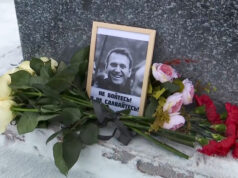
President Barack Obama meets with Russian President Vladimir Putin in Enniskillen, Northern Ireland, on June 17, 2013. |
Responding to North Korean threats, on March 15, 2013 the Obama administration substantially revised its missile defense program. It canceled the fourth phase of the European Phased Adaptive Approach (EPAA) comprising deployment of the Standard Missile (SM) -3-IIB interceptor missile for Europe. Instead it announced that it would deploy more ground-based interceptors in the U.S., adding to the thirty that are already in Alaskan silos. Washington will also develop more radar assets in Japan, pursue a possible third interceptor on the Eastern Seaboard, and modernize the kill vehicle atop long-range interceptor missiles. Although the administration denied it had acted with Russia in mind or cleared it with Russia, these decisions clearly represented a unilateral gesture to Moscow to resume arms control negotiations.
Unilateral U.S. Concessions
Yet this gambit has apparently not succeeded, even though North Korean rhetoric about missile threats to the U.S., Japan, and South Korea diminished. In addition, Deputy Minister of Defense Dmitry Rogozin said the U.S. move eliminated any threat to Russia. Other Russian officials claimed it opened a window of opportunity and invited the U.S. to begin negotiations at the Deputy Minister of Defense level. But negotiations to weaken this system are either unnecessary or an invitation to further concessions. Neither the Bush nor the Obama administrations had ever described the EPAA program as a threat to Russia, and Russian scientists, analysts, and military men admit as much when they say they possess necessary counter-capabilities. Furthermore, they also acknowledged the North Korean and Iranian threats based on joint U.S.-Russian analyses.
At various times the administration has proposed to Russia joint research efforts, system tests, modeling, exercises, and joint analysis of different variants of the U.S.-Russian framework of defense from common threats, all to no avail. Now the administration, for a third time and against Congressional resolutions, seeks to give Russia classified data to show that its fears are groundless. Yet because Moscow knows that no threat exists such submissions are merely unreciprocated and unjustified concessions.
The Imagined Threat of U.S. Missile Defense
Moreover, even if the SM-3-II B Interceptor was installed on schedule, it is quite unlikely that it could threaten Russia’s nuclear deterrent. Not only is Russia’s nuclear arsenal too large and diversified for the U.S. to eliminate or degrade it through defenses and a follow-on strike, physically it may also be impossible to do so. According to Stefan Forss of Finland’s Defense Staff College, and Uzi Rubin, the well-known Israeli scientist and politician, for these interceptors to target Russian weapons effectively, they must travel 50% faster than those missiles, which is impossible. The National Academy of Sciences confirmed this finding.
Clara Marina O’Donnell, writing for The Centre for European Reform notes:
The U.S. would be ill advised to increase the number of interceptors on the West—and possibly East—Coast. Studies have shown that the interceptors in Alaska and California do not work well either. According to Congress’ Government Accountability Office (GAO), ten out of the 30 interceptors rely on technology which has never intercepted a missile during tests. The GAO estimates that it will take several years to repair this technology, costing the U.S. taxpayer an additional $700 million. [Secretary of Defense Chuck] Hagel has promised to fix these glitches before the new interceptors are deployed. But the Pentagon does not yet have a solution to another big problem. None of its interceptors can distinguish between an incoming warhead and debris or decoys. (Ballistic missiles can easily carry decoys in addition to warheads.)
Nonetheless, Russia still considers missile defenses in Europe a threat and steadfastly maintains this position. Therefore the Obama administration must ask why Moscow insists on this intransigent position regarding U.S. missile defenses absent a real threat. While Russia deliberately incites domestic minds with foreign threats to generate popular support, that is hardly the whole answer. Rather, the answer lies in Russia’s overall security posture toward the United States.
Russia’s Security Posture
First, Russia’s approach clearly presupposes conflict with the U.S., its presumed main enemy. Second, Russia can deal with it only from a position of nuclear deterrence, thus continuing the Cold War’s mutual hostage relationship, and again presupposing hostility. Third, absent effective democratic control over Russia’s military and intelligence services, they freely fabricate worst-case threat assessments relating to the U.S., secure in the knowledge that, as President Putin told the G-8 press corps in 2007, “If the military says something is a threat, it is a threat.”
Indeed, according to all Russian leaders, U.S.-inspired military threats, particularly the missile defense “threat” to “strategic stability,” are growing and coming closer to Russia’s borders. Even though Deputy Foreign Minister Andrei Denisov correctly told an interviewer in 2011, “Luckily we have virtually no enemies in the world today,” that is not Moscow’s formal view. Former Chief of Staff Yuri Baluyevsky, who then moved to the Security Council, recently stated that, “The U.S. maintains a factor of preventive nuclear strikes in its and NATO’s strategy against Russia and/or China and this is tied to the missile defense program.” Similarly Foreign Minister Sergei Lavrov told an audience at the annual 2013 Munich Security Conference:
Even in the conditions of deficit of financial resources, an increase in military activities is observed in the north and centre of Europe, as if in these regions the security threats are mounting. Advancement of projects for NATO’s further expansion and advancement of [the] bloc’s military infrastructure to the East is continuing—as if there were no top-level statements on fatality of preserving dividing lines on the continent. Speaking of this, some of our European partners are now inventing new dividing lines, begin trying to artificially divide integration projects into “good” and “bad,” “friendly” and “alien.”
On February 27, 2013 President Putin told an expanded session of the Ministry of Defense Collegium:
We see how instability and conflict are spreading around the world today. Armed conflict continues in the Middle East and Asia, and the danger of the “export” of radicalism and chaos continues to grow in our neighboring regions. At the same time, we see methodical attempts to undermine the strategic balance in various ways and forms. The United States has essentially launched now the second phase in its global missile defense system. There are attempts to sound out possibilities for expanding NATO further eastward, and there is also the danger of militarization in the Arctic. All of these challenges—and they are just a few of the many we face—are of direct concern to our national interests and therefore also determine our priorities.
On February 20, 2012, then-prime minister and now President Putin said, “We continue to see new areas of instability and deliberately managed chaos. There also are powerful attempts to provoke such conflicts even within the direct proximity of Russia and its allies’ borders.” Since for Putin and his subordinates Russia’s borders comprise the old Soviet borders, we see here just how expansive these threat assessments are.
This is not merely a personal or new assessment; it also appears in Russia’s Foreign Policy Concept. In 2012, Putin wrote that the global economic-financial crisis is systemic and marks a transition to a new geopolitical era, and the world is entering into a new, prolonged, and painful period of turbulence:
The end result of the system that has developed in the 20 years since the collapse of the Soviet Union, including the phenomenon of unilateralism, is obvious. The former single center of power can no longer maintain global stability, while the new centers of influence are not yet ready to take over. Global economic processes and the military-political situation have become increasingly unpredictable and should be dealt with through the confident and responsible cooperation of states, primarily the permanent members of the UN Security Council and the G8 and G20 countries. We must keep working to overcome mutual suspicion, ideological prejudice and short-sighted self-interest. Instead of boosting development and stabilizing the global economic system, the world’s largest economic centers are creating an increasing number of problems and risks. Social, ethnic, and cultural tensions are growing rapidly. Destructive forces have strengthened dramatically and have shown their aggressive nature in some parts of the world ultimately threatening global security. The countries that are using military force to “export democracy” often become allies of these destructive forces.
The Ministry of Foreign Affairs of the Russian Federation produced the document, Russian Federation Foreign Policy Concept, ratified by Putin in February 2013. It makes the following points:
The principal and emblematic feature of the current international landscape is the deep-seated transformation of the geopolitical landscape, the essence of which is a transition to a polycentric or multi-polar world. A powerful factor in this transformation is the global economic crisis that is adding to global and regional economic and political turbulence.
Consequently international relations are becoming more unpredictable and tense. The West’s ability to dominate the world’s economics and politics continues to shrink as the center of global economic activity moves eastwards and the decentralization of international power continues with the Asia-Pacific continuing to rise. As new players emerge and the West declines, there is an increase in global competition that manifests itself in increasing instability in international relations. Even as the likelihood of a large-scale and/or nuclear war is decreasing, changes are necessarily occurring in the global correlation of forces. States seek to augment their offensive potential and develop new kinds of weapons, eroding the structure of global security and even the system of arms control treaties. Moreover, as competition grows around the sources of raw materials, their exchanges, and their markets, they could become a trigger for future conflicts (as expected in earlier Russian official and unofficial statements).
A Return to the Past
This line of thinking powerfully resembles Lenin’s 1916 treatise Imperialism: The Highest Stage of Capitalism that purportedly uncovered the global economic-political-strategic forces that caused World War I. This fact does not encourage those who wish to believe that Russia has firmly transcended the Soviet period. Furthermore, given such threat assessments, Russia must undertake a huge conventional and nuclear buildup to meet these growing threats and make its armed forces competitive with those of the U.S. and China by 2020. Nuclear weapons have pride of place in that program.
Statements by Russian commanders, the evidence of past and future Russian exercises, and of current naval and land force deployments, suggest that short-range and possibly tactical nuclear weapons have already been deployed to units in Europe and are plainly seen as war-fighting weapons that will be used. In other words, neither war nor use of nuclear weapons in Europe is unthinkable.
Indeed, Chief of the General Staff General Nikolai Makarov threatened preemptive nuclear strikes against missile defenses in 2012, as reported in The Washington Times. Furthermore, when it is recalled that Putin admitted in August 2012 that the war with Georgia was planned, along with the use of separatists, beginning in 2006, it becomes clear that European and Eurasian security cannot be taken for granted. As Donald Kagan memorably argued, peace cannot preserve itself. This suggests a possible reason why a 2012 study by the Swedish Defense Research Agency argued for committing more NATO ground forces to the Baltics. Russian policy, rhetoric, and deployments all suggest that Russia deems it vital to possess the means to intimidate Europe with the threat of nuclear and missile strikes if its neighbors pursue “anti-Russian” policies.
Unintended Consequences of U.S. Concessions
Thus the key military threat to Russian interests is the U.S. military presence in Europe that prevents and deters such intimidation, in particular the missile defense system, even though it was not originally intended for that purpose. Arguably these are the real reasons Moscow opposes missile defenses, and continues to sulk about the mere existence of the program. Therefore, unreciprocated concessions will earn not gratitude but contempt and a belief that the Obama administration is weak, confused, and can be pushed. Although the administration’s clear ambition is to defend the homeland and our Asian and European allies, while also mollifying Russian concerns, nevertheless, at least in Europe, ambition should be made of sterner stuff.
Stephen Blank is Douglas MacArthur Professor at the Strategic Studies Institute of the U.S. Army War College. The views expressed here do not represent those of the U.S. Army, Defense Department, or the U.S. Government.





